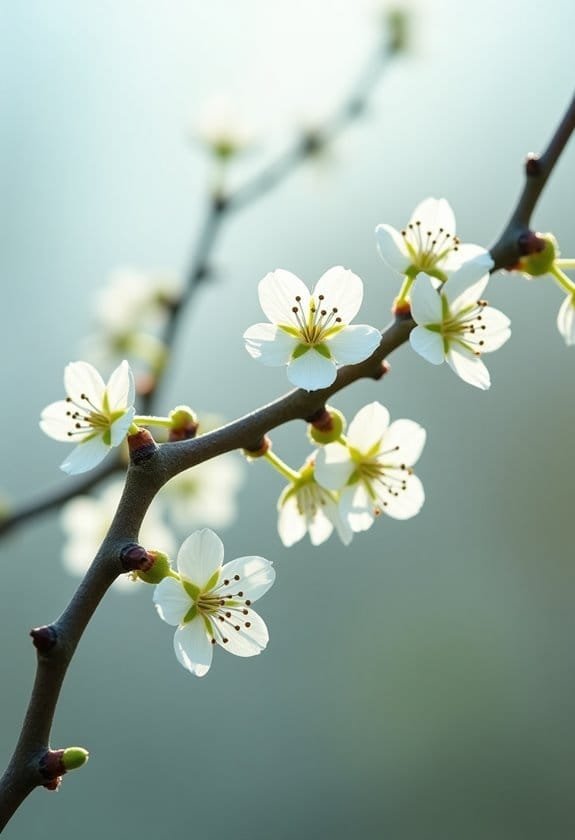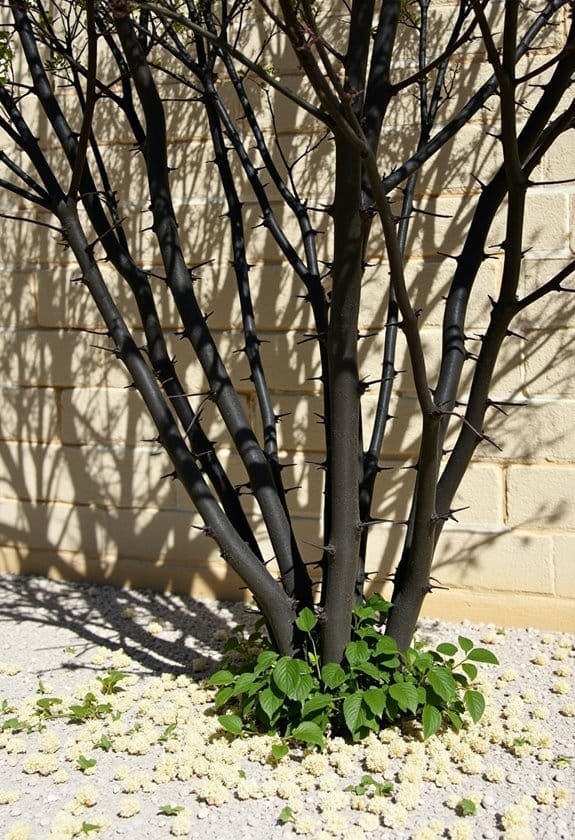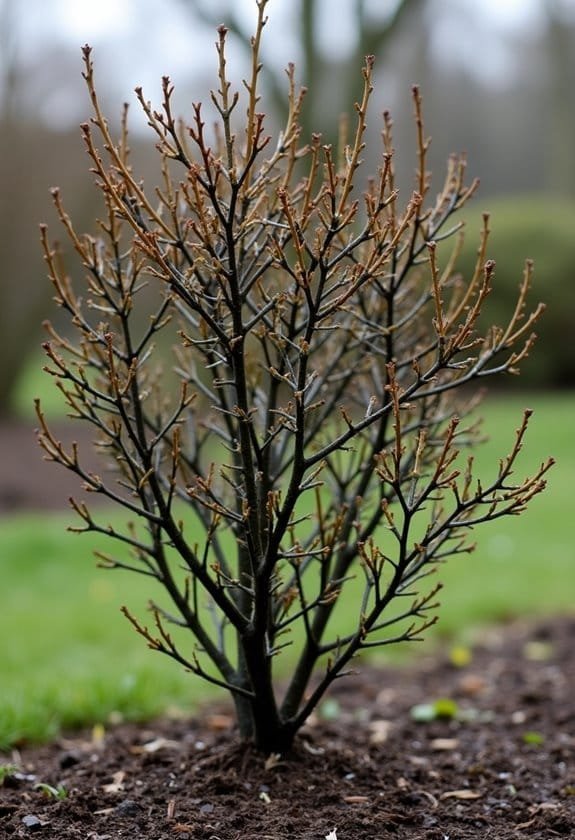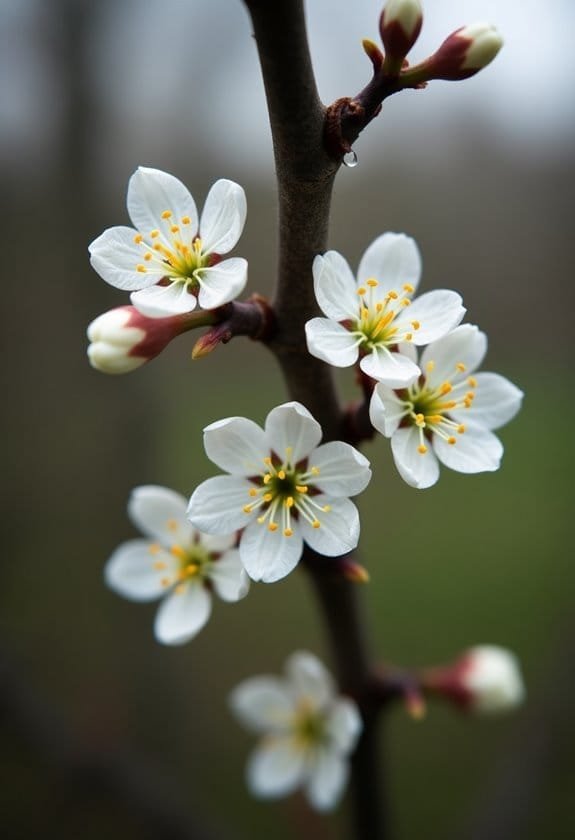Prunus spinosa, commonly known as blackthorn, is a resilient deciduous shrub that's become a cornerstone of European hedgerows. It grows up to 7 meters tall, featuring dense, thorny branches and oval leaves 2-4.5 cm long. The plant produces creamy-white flowers measuring 1.5 cm in diameter that bloom before foliage appears in early spring, making it an essential resource for early-emerging pollinators. Its distinctive blue-black sloe berries, measuring 10-12 mm, emerge after flowering and are traditionally used in preserves and flavoring gin. This adaptable species thrives in full sunlight and well-drained soils, while its ecological significance extends far beyond its practical applications.
Main Points
- Prunus spinosa is a thorny shrub growing up to 7 meters tall, producing dark blue-black sloe fruits and white spring flowers.
- Blackthorn grows naturally in Europe and western Asia, forming dense hedgerows that provide essential wildlife habitats and shelter.
- The plant produces edible sloe berries commonly used in making sloe gin and preserves, traditionally harvested after the first frost.
- White flowers appear before leaves in early spring, making it valuable for early-emerging pollinators and creating distinctive seasonal displays.
- The tough, dark wood is traditionally used for making walking sticks and shillelaghs, while its thorny branches create natural barriers.
Introduction

Prunus spinosa, commonly known as blackthorn, stands as a remarkable member of the Rosaceae family, characterized by its dense, spiny branches and resilient nature.
The species thrives throughout Europe, western Asia, and northwest Africa, where it forms an integral part of natural hedgerows and woodland margins, reaching heights of up to 5 meters.
This hardy shrub's scientific name reflects its distinctive features: "Prunus" referring to its classification within the plum genus, while "spinosa" aptly describes its thorny, protective branches that serve as both defense and shelter for various wildlife species.
Common Name
The dark-barked shrub commonly known as blackthorn derives its name from its distinctive features: deep-colored bark and sharp, defensive thorns. These characteristics have made blackthorn wood a formidable choice for traditional hedgerows and natural barriers across European landscapes.
The plant's fruit bears the name "sloe," which emerged from Middle English nomenclature, reflecting historical perceptions of the fruit's modest value in medieval times. This linguistic heritage extends across Eastern Europe, where variations of "slyva" in Ukrainian and "śliwa" in Polish demonstrate the plant's widespread cultural significance throughout the region.
The term "blackthorn" has woven itself into cultural expressions, especially in the phrase "sloe-eyed," which describes individuals with dark, enchanting eyes reminiscent of the plant's dusky fruit.
Its cultural importance is further exemplified by its connection to ancient Celtic traditions, particularly the festival of Imbolc, when the blackthorn's white blossoms herald the arrival of spring. This timing has cemented the plant's role in folklore and seasonal celebrations across various societies.
Scientific Name
Within botanical classification systems, Prunus spinosa stands as the scientific designation for blackthorn, belonging to the extensive Rosaceae family. This binomial nomenclature, established through rigorous taxonomic principles, reflects the plant's position within the broader genus Prunus, which encompasses numerous economically significant fruit trees including plums and cherries.
The specific epithet "spinosa" derives from the Latin word for thorn, serving as a descriptive marker that highlights one of the plant's most distinctive morphological features – its thorny branches. This naming convention provides important insight into the plant's physical characteristics while adhering to standardized botanical classification protocols.
In the scientific community, Prunus spinosa represents a well-documented species that flourishes across diverse geographical regions, from Europe to western Asia and parts of North Africa.
The plant's hermaphroditic flowers, which emerge before its leaves in early spring, play a crucial role in its reproductive strategy and ecological interactions. This timing of floral development distinguishes it from many other members of the Rosaceae family, contributing to its unique position within the taxonomic hierarchy.
Overview
Standing sentinel in hedgerows and woodland margins across Europe and western Asia, blackthorn commands attention with its dense, spiny branches that reach heights of up to 5 meters. This resilient deciduous shrub reveals its delicate beauty through a display of creamy-white flowers that emerge in early spring, preceding the oval leaves that measure between 2 and 4.5 centimeters in length.
As autumn approaches, blackthorn transforms its appearance with the development of its characteristic fruit, the sloe. These small, blue-black drupes possess an intensely astringent flavor when fresh, leading many foragers to wait until after the first frost before harvesting.
Beyond its aesthetic and culinary contributions, blackthorn serves as a cornerstone species in local ecosystems, providing essential shelter and sustenance for diverse wildlife populations. The plant's practical applications extend to traditional craftsmanship, where its exceptionally hard wood has earned recognition in the production of walking sticks and shillelaghs.
This versatile species continues to demonstrate its significance across ecological, cultural, and practical domains, embodying the intricate relationship between native flora and human utilization.
Key Features
Prunus spinosa stands as a striking deciduous shrub or small tree, reaching impressive heights of up to 5 meters with its dense, spiny branches and characteristic blackish bark.
The plant's oval leaves measure 2-4.5 cm in length, while its branches form an intricate network of natural defensive thorns.
In early spring, before the leaves emerge, the blackthorn bursts into life with creamy-white hermaphroditic flowers measuring 1.5 cm across, creating a spectacular display against the dark branches.
Growth Size
Reaching impressive heights of 5-7 meters (16-23 feet), blackthorn grows as either a large deciduous shrub or small tree with a distinctive branching pattern. The plant's robust structure develops through a network of densely arranged branches adorned with characteristic spiny twigs, creating an effective natural barrier in many landscapes.
Within this substantial framework, blackthorn exhibits remarkable proportions across its various features. Its oval leaves, measuring between 2 and 4.5 centimeters in length, display finely toothed margins and a slightly wrinkled texture that adds to their distinctive appearance.
The plant's reproductive elements are equally well-proportioned, with delicate creamy-white flowers spanning approximately 1.5 centimeters in diameter that emerge before the foliage in early spring. These blossoms later give way to the dark blue to purple sloes, measuring 10-15 millimeters in diameter, which are traditionally used to make sloe gin and other preserves.
The substantial size of both the overall plant and its individual components contributes to its significance in hedgerows and natural habitats, where it serves multiple ecological functions.
Appearance
This resilient shrub showcases distinctive features that make it instantly recognizable in the wild. The most striking characteristic is its dark brown to blackish bark, which has historically been prized where the wood has been used for walking sticks and traditional crafts.
Dense, spiny branches extend outward, creating an intricate network of protective thorns that serve as an effective natural barrier.
The plant's foliage presents an elegant contrast to its formidable thorns, with oval-shaped leaves measuring 2 to 4.5 cm in length. These leaves display a slightly wrinkled texture and feature precisely serrated margins, adding to the plant's visual complexity.
Before the leaves emerge in early spring, the blackthorn produces an abundance of delicate, creamy-white flowers, each measuring approximately 1.5 cm in diameter and forming perfect star shapes against the dark branches.
The transformation continues into autumn when the bush bears its characteristic sloes, which are spherical drupes measuring 10-12 mm across. These fruits develop a distinctive black coloration enhanced by a purple-blue waxy bloom, creating a striking visual display against the plant's thorny architecture.
Flowering Season
Nature's timing orchestrates blackthorn's flowering season in early spring, typically from March to April, when its creamy-white blossoms emerge before the leaves. These distinctive star-shaped flowers, measuring 1.5 centimeters in diameter, create a striking display against the dark branches, transforming the winter-bare shrub into a beacon of seasonal change.
The flowering strategy of Prunus spinosa demonstrates remarkable ecological adaptation, as the absence of leaves during blooming allows for ideal pollinator access to the hermaphroditic flowers. This timing maximizes reproductive success by guaranteeing unobstructed movement for various insect species seeking nectar and pollen.
The flowering season holds particular cultural significance in Celtic traditions, where it traditionally aligns with the festival of Imbolc, marking winter's shift toward spring.
The plant's reproductive cycle reflects a delicate balance between biological imperatives and environmental conditions, with the early flowering season providing a vital advantage in the race for pollination. These blossoms serve as an essential early-season resource for pollinators, while their timing helps guarantee successful fruit development during the following months.
Growing Requirements

Prunus spinosa requires full sunlight exposure and thrives in well-drained soil conditions that can range from neutral to distinctly alkaline.
The plant's robust nature allows it to flourish in various soil types, though it shows marked distress in highly acidic environments or locations with significant shade coverage.
For ideal growth in temperate climates, consistent moisture levels must be maintained throughout the growing season, with the plant demonstrating particular resilience once established in its preferred conditions.
Light
Successful cultivation of blackthorn depends largely on proper light exposure, with full sunlight providing ideal growing conditions. This versatile shrub, commonly used for making sloe gin and traditional hedgerows, demonstrates remarkable adaptability to various light conditions, though it performs best in full sun exposure.
While blackthorn can tolerate semi-shaded environments, its growth and flowering capabilities become significantly diminished when light levels are insufficient. The plant's photosynthetic processes require adequate sunlight to produce the energy necessary for robust development and abundant fruit production.
In optimal lighting conditions, blackthorn's distinctive white blossoms emerge more prolifically in early spring, creating a spectacular display that supports local pollinators.
For gardeners considering blackthorn cultivation, strategic placement in well-lit areas is essential for achieving the plant's full potential. The shrub's ability to thrive in full sunlight complements its tolerance for alkaline soils, making it particularly well-suited for open countryside settings and sunny garden borders.
However, careful consideration should be given to avoid deeply shaded locations, where the plant's natural vigor and fruiting capacity may be compromised.
Soil
The remarkable adaptability of blackthorn shines through in its soil preferences, thriving in light, medium, and heavy compositions alike. This versatile shrub demonstrates exceptional flexibility in various growing conditions, making it a valuable species for diverse landscape applications.
When it comes to moisture requirements, blackthorn performs best in well-drained soils that maintain consistent moisture levels throughout its growing cycle. Its tolerance for alkaline conditions is particularly significant, as the plant can flourish in environments where many other species might struggle to establish themselves. This adaptability to high pH levels has made it frequently used in restoration projects and hedgerow plantings across various terrains.
However, blackthorn does have its limitations. The shrub shows marked resistance in disturbed environments, yet it exhibits diminished vigor when exposed to highly acidic soil conditions or heavily shaded areas.
Despite these constraints, its overall soil adaptability remains impressive, allowing it to establish robust populations in anthropogenic habitats where soil conditions have been altered by human activity, such as along roadways and in reclaimed industrial sites.
Water
Maintaining proper water balance stands out as a critical factor in blackthorn's cultivation success. While the shrub demonstrates remarkable adaptability to various soil conditions, its water requirements deserve careful attention, particularly during establishment phases when young plants develop their foundational root systems.
This resilient species exhibits a moderate water demand, thriving with consistent moisture yet displaying tolerance for brief dry spells once established. During prolonged periods without rainfall, supplemental watering becomes essential to prevent stress and maintain ideal growth patterns.
The plant's relationship with water directly influences its reproductive success, as adequate moisture levels greatly impact both flowering intensity and subsequent fruit development.
In coastal environments, blackthorn's notable tolerance to slightly saline conditions enables it to utilize water resources that might prove challenging for less adaptable species. While the plant demonstrates considerable drought resilience, maintaining consistent soil moisture, especially during critical growth phases, guarantees robust development and abundant fruiting.
Regular irrigation practices, particularly during dry seasons, help maximize the shrub's ornamental and productive potential.
Temperature
While adapting to diverse climatic conditions, blackthorn demonstrates remarkable resilience within temperate zones, flourishing in environments that experience mild winters and warm summers. Its robust nature enables it to withstand temperature extremes, particularly impressive during winter months when it can survive temperatures plummeting to -15°C (5°F).
The plant's temperature requirements align perfectly with its growth cycle, particularly during its critical flowering period in early spring. As winter's grip loosens and temperatures begin their gradual ascent in March and April, blackthorn bursts into bloom, taking advantage of the warming conditions to attract pollinators.
However, young plants require careful consideration regarding temperature fluctuations, especially during late spring when unexpected frosts can pose a significant threat to tender new growth and delicate blossoms.
In terms of soil temperature, blackthorn exhibits notable flexibility, though it shows a marked preference for well-drained substrates that maintain moderate warmth during summer months.
This adaptation guarantees ideal root development and nutrient uptake throughout the growing season, contributing to the plant's overall vigor and longevity.
Pollinator Criteria
Prunus spinosa's early spring flowers serve as a crucial lifeline for awakening pollinators, particularly bees emerging from winter dormancy.
The hermaphroditic blooms, measuring 1.5 cm across, produce abundant nectar and pollen that sustain these essential insects during a critical period when few other food sources are available.
These creamy-white flowers rely entirely on insect pollination for reproduction, creating a mutually beneficial relationship where the plant's survival depends on pollinators, while simultaneously supporting their populations through both nourishment and shelter.
Attracted Pollinators
Early spring heralds the emergence of blackthorn's creamy-white flowers, which serve as essential nectar and pollen sources for various pollinators. The hermaphroditic blooms produce an abundance of these important resources at a critical time when few other flowering plants are available in temperate ecosystems.
Among the attracted pollinators, bees and butterflies are particularly drawn to blackthorn's accessible flower structure and generous nectar rewards. These industrious insects navigate through the dense thickets, which not only provide sustenance but also offer protective shelter for nesting and refuge from predators.
The relationship between blackthorn and its pollinators exemplifies a remarkable ecological partnership that has evolved over countless generations.
The timing of blackthorn's flowering period is especially significant for supporting early-emerging pollinator populations. As these insects awaken from winter dormancy, they rely heavily on the plant's readily available resources to rebuild their energy reserves.
This synchronized flowering strategy helps maintain healthy pollinator communities, which in turn supports the broader ecosystem's biodiversity and reproductive success.
Pollination Method
The pollination strategy of blackthorn relies on its hermaphroditic flower structure, which combines both male and female reproductive parts within each blossom. This unique arrangement enables the plant to facilitate self-pollination when necessary, though cross-pollination through insect activity typically yields more successful fruit production.
In early spring, before the leaves emerge, blackthorn produces an abundance of creamy-white flowers that serve as vital nectar sources for emerging pollinators. The timing of this flowering period is particularly significant, as it synchronizes with the seasonal emergence of various pollinating insects, especially bees, which are essential for effective cross-pollination between different blackthorn specimens.
The plant's reproductive success is further enhanced by its growth pattern, which forms dense thickets that provide shelter for pollinating insects. These protective habitats encourage sustained pollinator activity around the flowering shrubs, increasing the likelihood of successful fertilization.
The male stamens and female pistils within each flower are perfectly positioned to maximize contact with visiting insects, ensuring efficient pollen transfer and subsequent development of the characteristic sloe fruits.
Care & Maintenance

Successful cultivation of Prunus spinosa starts with selecting a well-drained planting site that receives abundant sunlight, positioning the shrub where its thorny branches can develop into an effective natural barrier.
The plant's ongoing care requires regular spring pruning to maintain its dense structure, coupled with consistent watering during establishment and occasional fertilization to promote robust growth.
While blackthorn proves relatively self-sufficient once established, it flourishes when planted alongside complementary species like hawthorn and elder, which share similar growing requirements and create a diverse hedgerow ecosystem.
Planting Tips
Proper planting and maintenance of Prunus spinosa starts with choosing the right location and timing. This resilient shrub, traditionally used to make walking sticks due to its sturdy branches, requires careful consideration of soil conditions and sunlight exposure for peak growth.
For successful establishment, plant Prunus spinosa during early spring or autumn when soil moisture levels are typically higher and temperatures are moderate. The planting site should receive full sunlight and offer well-drained soil, though the shrub demonstrates remarkable adaptability to various soil compositions, including heavy clay.
When determining placement, allow for significant spacing between plants, as the shrub's vigorous suckering habit can lead to extensive thicket formation over time. While Prunus spinosa tolerates alkaline conditions admirably, it's crucial to avoid highly acidic soils that could impede growth.
The planting hole should be twice the width of the root ball and at the same depth, ensuring the crown sits slightly above soil level to prevent waterlogging. Incorporate organic matter into the backfill soil to enhance drainage and provide initial nutrients for establishment.
Ongoing Care
Maintaining established Prunus spinosa requires surprisingly little effort, though certain routine practices guarantee perfect health and growth. Regular walking inspections around these robust shrubs allow gardeners to monitor their development and identify potential issues before they become significant problems.
While blackthorn demonstrates remarkable resilience in various soil conditions, young plants benefit from consistent watering during dry periods, particularly in their first two growing seasons.
The shrub's maintenance primarily involves occasional pruning to control its spreading habit and remove any dead or compromised branches, ensuring the plant maintains its natural form and vigor.
Though fertilization isn't typically necessary, applying organic mulch in spring provides multiple benefits, including moisture retention and weed suppression around the plant's base.
Vigilant monitoring for common afflictions, such as blossom wilt and pocket plum fungus, enables early intervention when required.
For prime growth, these hardy plants should be positioned in locations receiving full sun to partial shade, with adequate spacing of at least 1.5 meters between specimens to accommodate their dense branching pattern and natural spread.
Suggested Companions
Planting alongside compatible species stands out as an important strategy for maximizing Prunus spinosa's growth potential and ecological benefits. The most notable companion for Blackthorn is Crataegus monogyna (Hawthorn), as these two species create an impenetrable hedgerow where their wood is used by wildlife for shelter and nesting.
Introducing wildflowers as understory plants serves multiple purposes in supporting Blackthorn's health and productivity. These flowering companions attract beneficial insects that provide natural pest control while enhancing the overall biodiversity of the hedgerow ecosystem. The combination creates a layered habitat structure that benefits various wildlife species throughout the seasons.
For ideal growth conditions, gardeners should consider incorporating moisture-retaining companion plants that don't compete aggressively for resources.
When planning companion arrangements, it's vital to maintain adequate spacing between shrubs to guarantee proper air circulation and access for maintenance activities like pruning and mulching. This thoughtful approach to companion planting not only supports the Blackthorn's development but also contributes to creating a resilient and sustainable landscape that supports local wildlife populations.
Common Issues
Prunus spinosa faces several significant fungal challenges, with blossom wilt and pocket plum fungus (Taphrina pruni) being particularly destructive to fruit development and overall plant health.
These pathogens can manifest through distorted growth patterns, wilted flowers, and malformed fruits, often requiring immediate intervention through proper pruning and fungicidal treatments.
The plant's vulnerability extends beyond diseases to include grazing pressure from wildlife and the risk of thorns causing septic infections in handlers, making protective measures essential for both plant and human safety.
Pests/Diseases
Like many fruit-bearing shrubs, blackthorn faces several significant pest and disease challenges that can impact its health and productivity. One of the most concerning diseases is blossom wilt, a fungal infection that can devastate flowering potential and subsequently reduce fruit production across entire hedgerows.
The pocket plum fungus, scientifically known as Taphrina pruni, presents another serious threat by causing distinctive malformations in blackthorn fruits, effectively rendering them unusable. This condition manifests through elongated, distorted fruits that lack the characteristic round shape of healthy specimens.
Additionally, bacterial canker can trigger progressive dieback in branches, leading to a systematic decline in the plant's overall health.
Pest management becomes particularly important when dealing with aphid infestations, as these small but persistent insects weaken the plant by extracting essential nutrients from its tissue.
To maintain blackthorn's health and vigor, regular monitoring and preventive measures are essential, including proper pruning techniques to improve air circulation and remove infected material, along with maintaining ideal growing conditions to boost the plant's natural defense mechanisms.
Solutions
Successful management of blackthorn requires addressing several common challenges that gardeners frequently encounter. One of the most critical solutions involves proper protective measures when handling these thorny plants, with thick gardening gloves being essential to prevent painful punctures and potential infections.
For ideal fruit production and flavor development, timing the harvest strategically after the first frost proves instrumental, as this natural process helps break down the harsh astringent compounds in the berries. Implementing a regular monitoring system for fungal diseases, particularly blossom wilt, enables early detection and swift intervention to maintain plant health.
To enhance the ecological value of blackthorn plantings, incorporating them into mixed hedgerows creates crucial wildlife corridors and supports local biodiversity.
When utilizing blackthorn wood for practical purposes, proper seasoning becomes paramount, as adequately dried wood not only burns more efficiently but also produces considerably less smoke.
These solutions, when implemented systematically, help gardeners maximize the benefits of this versatile plant while minimizing potential drawbacks and maintenance challenges.
Summary

The versatile blackthorn shrub stands as a remarkable species native to Europe, western Asia, and northwest Africa, growing up to 5 meters tall with its distinctive spiny branches and early spring white flowers.
Its densely packed structure creates impenetrable hedgerows that serve as essential wildlife habitats, supporting diverse ecosystems throughout temperate regions.
The plant's ecological significance extends beyond its structural benefits, as its small, dark fruits, known as sloes, provide sustenance for numerous bird species and insects.
These 10-12 mm drupes, while initially astringent, transform after the first frost into valuable ingredients for traditional beverages, especially sloe gin.
The blackthorn's adaptability to various soil conditions has guaranteed its widespread presence across different landscapes, from woodland margins to scrubland areas.
Throughout history, the blackthorn's dense, durable wood has proven crucial for crafting practical items like walking sticks and traditional Irish shillelaghs.
This combination of ecological importance, culinary applications, and practical utility has cemented the blackthorn's position as a significant species in both natural ecosystems and human culture.


